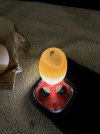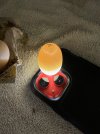atirzero
New Member
I saw my girl tortoise (15ish y/o) yesterday morning before leaving for work and everything seemed normal. Then my partner calls me that evening saying she laid 4 eggs! No one was present while she was laying - they were just there when he got home. I had no idea she was pregnant at all! There is a male present (8ish y/o) and they have been in contact with each other. I was keeping them in the same enclosure til I noticed the aggression and learned better (this is my first year owning tortoises so I’m trying my best).
I’ve been madly googling (how I ended up here) trying to figure out what to do til my incubator arrives. I ordered the ZooMed Reptibator and the suggested incubation substrate. I will buy an additional hygrometer and thermometer as suggested in other incubation threads here.
This is what I’ve managed to do for the eggs so far. Trying to keep the humidity levels up but I have this open top tank situation (again, working on improving their habitat as I learn) so suggestions on what to do in the meantime for the eggs are appreciated. The bowls of water, baking sheet over the top to keep moisture inside the enclosure, and freshly re-dampened enclosure substrate are what I’ve managed so far.
My partner was the one that found the eggs and did not know about not rotating them but since they were less than 24 hours old at that point, I’m hoping they’ll be okay. According the the previous caretaker, she had one clutch prior to this but it was unviable (which I hear can be common?) so I’m thinking/hoping this second batch actually has a good chance of hatching.
Both tortoises have been separated from the eggs.
Should I be on the look out for more eggs? I read somewhere that she might produce additional clutches this season, even if no more mating occurs.
Any and all help is greatly appreciated. I’m trying my best to do this right!

I’ve been madly googling (how I ended up here) trying to figure out what to do til my incubator arrives. I ordered the ZooMed Reptibator and the suggested incubation substrate. I will buy an additional hygrometer and thermometer as suggested in other incubation threads here.
This is what I’ve managed to do for the eggs so far. Trying to keep the humidity levels up but I have this open top tank situation (again, working on improving their habitat as I learn) so suggestions on what to do in the meantime for the eggs are appreciated. The bowls of water, baking sheet over the top to keep moisture inside the enclosure, and freshly re-dampened enclosure substrate are what I’ve managed so far.
My partner was the one that found the eggs and did not know about not rotating them but since they were less than 24 hours old at that point, I’m hoping they’ll be okay. According the the previous caretaker, she had one clutch prior to this but it was unviable (which I hear can be common?) so I’m thinking/hoping this second batch actually has a good chance of hatching.
Both tortoises have been separated from the eggs.
Should I be on the look out for more eggs? I read somewhere that she might produce additional clutches this season, even if no more mating occurs.
Any and all help is greatly appreciated. I’m trying my best to do this right!




